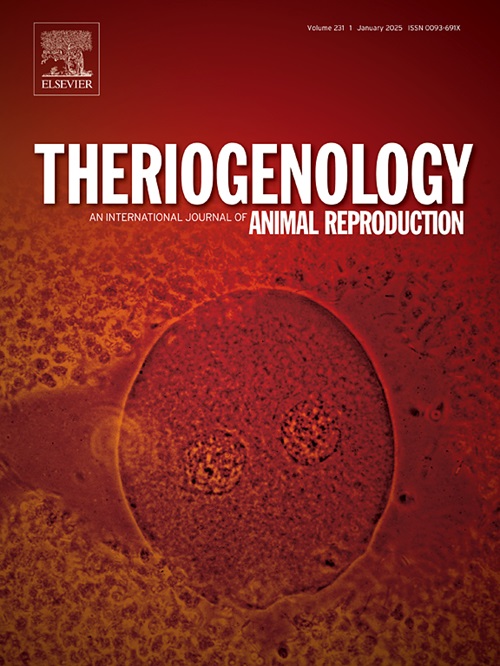兔输卵管和子宫液细胞外囊泡的表征和miRNA谱分析
IF 2.4
2区 农林科学
Q3 REPRODUCTIVE BIOLOGY
引用次数: 0
摘要
输卵管和子宫为早期胚胎发育提供了一个支持性的环境,在这个环境中,有效的胚胎与母体的交流对妊娠成功至关重要。来自输卵管(OF)和子宫液(UF)的细胞外囊泡(ev)是这种交流的关键介质,运输生物活性分子,如蛋白质、脂质、DNA和调控rna。其中,由于其在调节生殖过程中的作用,microRNAs (miRNAs)特别有趣。尽管在电动汽车研究中代表性不足,但由于其可诱导排卵、可控制的生殖生理以及与人类植入动力学的相似性,兔子提供了一个强大的模型。本研究旨在通过分离、表征和分析来自OF- ev和uf - ev的miRNA货物,揭示ev如何影响关键的生殖过程。我们在OF-EVs和UF-EVs中都发现了388个mirna,其中18个mirna在UF-EVs中丰度明显高于OF-EVs组,而5个mirna的丰度低于OF-EVs组,这表明它们在胚胎-母体交流中起着不同的作用。最丰富的mirna包括ocu-miR-148a-3p、ocu-let-7i-5p和ocu-miR-10b-5p,与胚胎发育和着床有关。靶基因预测分析显示,of - ev的mirna与MAPK、Hippo、TGF-β、Ras、PI3K-Akt和mTOR通路相关,而uf - ev的mirna与Hippo、PI3K-Akt、FoxO、内吞噬和mTOR通路相关,这些通路对细胞增殖、分化、免疫调节和胚胎-母体相互作用至关重要。我们的研究结果表明,家兔生殖液中的ev可能在早期胚胎发育中起重要作用。未来的研究应重点关注这些关键候选mirna的功能验证,特别是那些涉及生殖生理学的mirna,为生殖生物技术和兽医学提供有希望的见解。本文章由计算机程序翻译,如有差异,请以英文原文为准。
Characterization and miRNA profiling of extracellular vesicles from rabbit oviduct and uterine fluids
The oviduct and uterus provide a supportive environment for early embryonic development, where effective embryo–maternal communication is essential for pregnancy success. Extracellular vesicles (EVs) from oviductal (OF) and uterine fluids (UF) are key mediators of this communication, transporting bioactive molecules such as proteins, lipids, DNA, and regulatory RNAs. Among these, microRNAs (miRNAs) are particularly interesting due to their role in modulating reproductive processes. Although underrepresented in EVs research, the rabbit offers a robust model owing to its inducible ovulation, controlled reproductive physiology, and similarities to human implantation dynamics. This study aims to uncover, in does, how EVs could influence key reproductive processes by isolating, characterizing, and analyzing the miRNA cargo from OF- and UF-EVs. We identified 388 miRNAs in both OF-EVs and UF-EVs, 18 miRNAs were significantly more abundant in UF-EVs, while 5 were less abundant compared to OF-EVs group, suggesting distinct roles in embryo-maternal communication. The most abundant miRNAs, included ocu-miR-148a-3p, ocu-let-7i-5p, and ocu-miR-10b-5p, related to embryo development and implantation. Target gene prediction analysis revealed that OF-EVs miRNAs are linked to MAPK, Hippo, TGF-β, Ras, PI3K-Akt, and mTOR pathways, while UF-EVs are associated with Hippo, PI3K-Akt, FoxO, endocytosis, and mTOR pathways, essential for cell proliferation, differentiation, immune regulation, and embryo-maternal interactions. Our findings suggest that EVs in rabbit reproductive fluids could play a fundamental role in early embryonic development. Future research should focus on the functional validation of these key candidate miRNAs, particularly those involved in reproductive physiology, offering promising insights for reproductive biotechnology and veterinary medicine.
求助全文
通过发布文献求助,成功后即可免费获取论文全文。
去求助
来源期刊

Theriogenology
农林科学-生殖生物学
CiteScore
5.50
自引率
14.30%
发文量
387
审稿时长
72 days
期刊介绍:
Theriogenology provides an international forum for researchers, clinicians, and industry professionals in animal reproductive biology. This acclaimed journal publishes articles on a wide range of topics in reproductive and developmental biology, of domestic mammal, avian, and aquatic species as well as wild species which are the object of veterinary care in research or conservation programs.
 求助内容:
求助内容: 应助结果提醒方式:
应助结果提醒方式:


